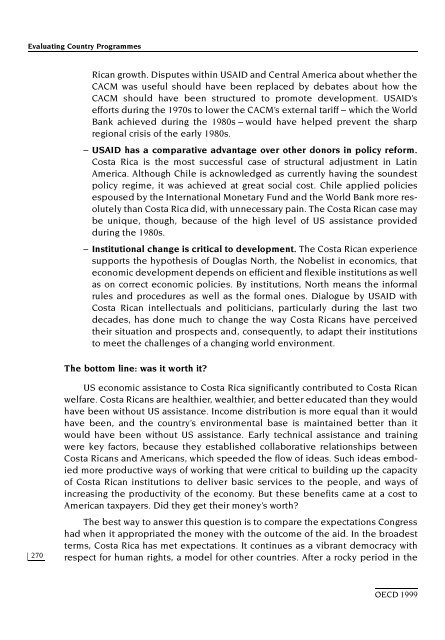Evaluating Country Programmes - OECD Online Bookshop
Evaluating Country Programmes - OECD Online Bookshop
Evaluating Country Programmes - OECD Online Bookshop
Create successful ePaper yourself
Turn your PDF publications into a flip-book with our unique Google optimized e-Paper software.
<strong>Evaluating</strong> <strong>Country</strong> <strong>Programmes</strong><br />
270<br />
Rican growth. Disputes within USAID and Central America about whether the<br />
CACM was useful should have been replaced by debates about how the<br />
CACM should have been structured to promote development. USAID’s<br />
efforts during the 1970s to lower the CACM’s external tariff – which the World<br />
Bank achieved during the 1980s – would have helped prevent the sharp<br />
regional crisis of the early 1980s.<br />
– USAID has a comparative advantage over other donors in policy reform.<br />
Costa Rica is the most successful case of structural adjustment in Latin<br />
America. Although Chile is acknowledged as currently having the soundest<br />
policy regime, it was achieved at great social cost. Chile applied policies<br />
espoused by the International Monetary Fund and the World Bank more resolutely<br />
than Costa Rica did, with unnecessary pain. The Costa Rican case may<br />
be unique, though, because of the high level of US assistance provided<br />
during the 1980s.<br />
– Institutional change is critical to development. The Costa Rican experience<br />
supports the hypothesis of Douglas North, the Nobelist in economics, that<br />
economic development depends on efficient and flexible institutions as well<br />
as on correct economic policies. By institutions, North means the informal<br />
rules and procedures as well as the formal ones. Dialogue by USAID with<br />
Costa Rican intellectuals and politicians, particularly during the last two<br />
decades, has done much to change the way Costa Ricans have perceived<br />
their situation and prospects and, consequently, to adapt their institutions<br />
to meet the challenges of a changing world environment.<br />
The bottom line: was it worth it?<br />
US economic assistance to Costa Rica significantly contributed to Costa Rican<br />
welfare. Costa Ricans are healthier, wealthier, and better educated than they would<br />
have been without US assistance. Income distribution is more equal than it would<br />
have been, and the country’s environmental base is maintained better than it<br />
would have been without US assistance. Early technical assistance and training<br />
were key factors, because they established collaborative relationships between<br />
Costa Ricans and Americans, which speeded the flow of ideas. Such ideas embodied<br />
more productive ways of working that were critical to building up the capacity<br />
of Costa Rican institutions to deliver basic services to the people, and ways of<br />
increasing the productivity of the economy. But these benefits came at a cost to<br />
American taxpayers. Did they get their money’s worth?<br />
The best way to answer this question is to compare the expectations Congress<br />
had when it appropriated the money with the outcome of the aid. In the broadest<br />
terms, Costa Rica has met expectations. It continues as a vibrant democracy with<br />
respect for human rights, a model for other countries. After a rocky period in the<br />
<strong>OECD</strong> 1999

















![CQE=U]^\]Z: KAZAKHSTAN - OECD Online Bookshop](https://img.yumpu.com/3915768/1/190x253/cqeuz-kazakhstan-oecd-online-bookshop.jpg?quality=85)